| BREAD |
|
|
|
Ricordi di Torricella
Memories of Torricella
| BREAD |
|
|
|
|
|
It was early in July, after a spring season that had been rich in
rain, at last the sun had been shining warmly for several days The wheat-fields, however, were not yet ripe enough for harvesting; last year’s leftovers had come to an end, even though they had been administered thriftily: there was no pasta or bread for the people, nor bran for the animals of the “massarì”. The harvest of wheat from the previous year had been ravaged and drastically reduced by hailstorms. Despite that, its use had been managed carefully in order to reach the new season’s crop without difficulty. But by spring, several neighbours, who had suffered much worse damage from the hail, had needed to ask my grandparents for a loan of several “muzzett” of wheat (“muzzett” means a bushel: it is both the unit of measure for grain which is about 30 kilogrammes and also the name given to the cylindrical recipient for measuring it out, made of staves of wood with an iron slat starting from the centre of the base and going right up to the handle that runs across the opening of the recipient.) |
|
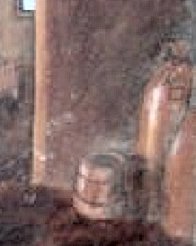 Figure 3 “lu muzzett” near some sacks of grain |
 Figure 4 “lu muzzett” seen from above |
|
Even though they knew that this would put them at risk of not
having enough to last until the next crop was gathered in, my grandparents, with
the customary, unobtrusive generosity typical of the peasant civilisation,
readily did everything in their power to help those more unfortunate than
themselves. In thinking about how to get the daily bread for the following days, amongst the many hypotheses, my grandfather wanted to make a final on-the-spot inspection of the south western part of the field next to “massarì”, in which that year the wheat was being grown. The land bordered on the east with the road and sloped gently down towards “lu foss” (the stream), which formed the border on the whole of the southern side; its wide, steep embankments were covered by many self-seeded trees, chiefly elms and oaks, but also various types such as plum, cherry, apple, rowan (mountain ash); the underbrush was also thick with a multitude of bushes and thousands of types of weeds. Finally to the south west, where the slope ended and it formed almost a small hill, my grandfather had picked out on the top of that hill a small tract of that immense field of wheat that could already be harvested. |
||
|
|
||
| The next day, at cockcrow, we were already ready; on this occasion only our own family had been mobilised, since there was only a small amount of work to be done. When the first light of dawn began to cancel out the first stars from a night that had been immense, luminous and perfumed, my grandfather and I went out from the house armed with “falgi” (scythe or reaping hook), cane thimbles to protect the fingers of our left hands, “lu cecine” (a terracotta recipient) holding water to drink and a bottle of wine; to protect us from the sun, we wore light clothing that covered our entire bodies, and we had large wide-brimmed straw hats on our heads to ensure we had a minimum of shade. | ||
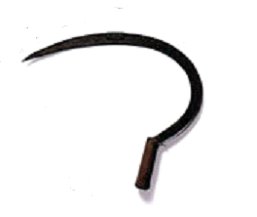 Figure 6 “falgi” - ancient scythe |
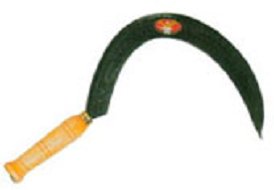 Figure 7 “falgi” - modern scythe |
|
|
At Torricella in the first few days of July, dawn begins before
four in the morning; during the brief walk we did not think about the “ungodly
hour” nor about the work that awaited us beneath the July sun, but solely about
the fact that that day, maybe by our efforts, we would have been able to resolve
our problem. At that hour of the morning the air was fresh and pleasant and once we had arrived at the place, the first thing to be done was my training. There was no need to study convoluted theories, nor dry abstract explanations; actually, far from being discouraged, I was in a hurry to do something that I wanted to do with the greatest of interest; my grandfather without thinking about it applied the method widely used by the peasant civilisation to teach the young. He told me: watch what I am doing and do it in the same way. With the greatest of attention I copied all his movements. |
||
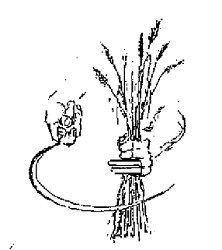 Figure 8 reaping (harvesting) |
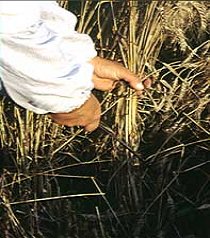 Figure 9 reaping (harvesting) |
|
|
I saw that he gripped the “falgi” in his right hand; he bent over
and with his left hand he took hold of a bunch of wheat stalks about fifteen
centimetres above the ground, he grasped them in his left hand and with the
“falgi” in his right hand he cut the stems below his left wrist taking care not
to injure his left hand by mistake; to decrease this risk he protected his left
ring and little fingers with thimbles that we had made from a cane; the inner
part of the thimbles was much shorter than the outer part; the former protected
the end phalanx of the fingers and at the same time supported the thimble; the
longer part protected the whole finger; the missing inner part allowed the
fingers to bend freely. In cutting the wheat my grandfather took care not to shake it too much, so as to conserve the whole ear and not waste any of the precious grain it contained. The fistfuls of harvested stalks were piled up on the ground with the ears all facing in the same direction. Every now and again he stopped to sharpen the “falgi”: he moistened the “cute” (whetstone) with water contained in the whetstone’s sheath and then passed the whetstone, rapidly, on the upper and lower blade edges of the scythe. |
||
|
|
||
| When he had harvested enough stalks of wheat he tied them together to get “le manoppr” (sheaves of wheat). | ||
|
|
||
|
After a few minutes I began my activities as a harvester. I was proud to make my contribution; I observed that from that moment not two but four arms were at work to resolve our problem. I dropped ears of grain, my thimbles fell off, I risked wounding myself with the “falgi” that we had made so sharp the evening before. |
||
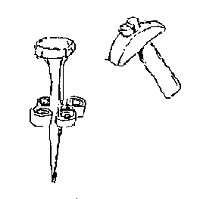 Figure 12 small anvil and hammer to sharpen“i falgi” |
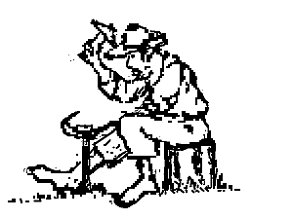 Figure 13 sharpening the “falgi” |
|
|
Each time I made a mistake I stopped for a moment to see how my
grandfather did it, to avoid making the same mistake again. After a few hours I was harvesting with such security that, on my own initiative, I tried to remove the bothersome thimbles; a few minutes later the work had to be interrupted because I had injured a finger. My grandfather treated me patiently: he stopped the bleeding with cold water; to make the wound heal he applied to it those white discs that you find inside canes (many years later I found out that these consisted of pure, sterile cellulose); on top of that he put on a dressing using his cotton handkerchief; then to cover all of this he had to make me a very much larger thimble. This whole interruption was quite short but it for me it was highly instructive. |
||
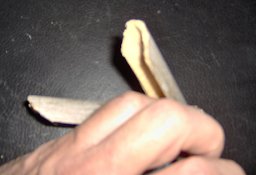 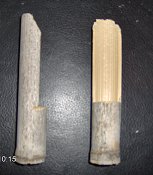 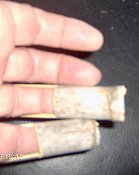 Figure 14 Thimbles made of cane to protect the ring and little fingers of the left hand |
||
|
Gradually, as the small piles of harvested wheat reached about 30
centimetres in diameter, my grandfather tied them with a bunch of wheat stalks
cut to the full length of their height; he inserted these underneath the piles
and joined the two ends of this unusual binding, twisting them together towards
the right; when the tension was sufficiently firm, he took the opposite end to
the ears of wheat and threaded it beneath the ligature, all the time taking care
not to damage the ears of grain that formed a part of the binding itself. Then it all seemed logical and normal to me, but today I am also able to note that to tie those bundles of wheat he was using a biodegradable material and nothing was wasted, so that when it came to threshing time those bindings turned back into ears of grain just like all the others; to carry out that operation we did not pollute anything, no-one in any part of the world was forced to do thankless work, or cause pollution, in order to produce and those bindings put them to use. Harvesting is very hard work because you are always bent over under the July sun: it is tiring for everyone but it was all the more so for someone like me, because I had not lived there previously, so at nine years old I had never done that work before. During the course of the day we often drank water and especially wine to regain our strength. |
||
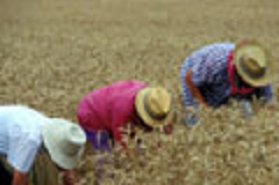 Figure 15 harvesters at work |
||
|
Every now and again, however, I would stop working briefly for
what for me was an essential rest. I watched my grandfather who moved calmly, without any hustle but without stopping, following an ancestral rhythm that almost seemed like a dance; I looked around and saw that we were immersed in a sea of a blond crop that was ripening in the sun; that brightly shining sun and the air so pure and transparent highlighted all the shapes and colours of nature, strong and gentle, that surrounded us; I felt that even I myself was a part of that vastness; the silence was only broken by the humming of insects and the twittering of birds nesting in the trees growing on the banks of “lu foss”; the air was full of promises; every now and then a light gust of perfumed wind made the crop ripple and gave back a little energy to us reapers. At a distance of so many years the memory of this experience reminds me of certain paintings by Van Gogh and of the journey into their colours that Akira Kurosawa makes one of his characters undergo in his film “Sogni” (“Dreams”). |
||
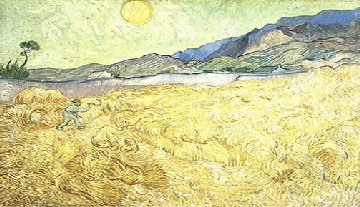 Figure 16 a field of wheat with reaper also charmed Van Gogh |
||
|
A few hours later my grandmother joined us, bringing our
breakfast, so we stopped and took shelter in the shade of one of the trees by
“lu foss”. It was a very tasty breakfast; even after so many years I have never forgotten some of the things we ate that day, when we had neither bread nor pasta; as usual we sat on a heavy blanket and we savoured: a type of pizza made with “grandinie” (maize flour), lean ham cut in chunks, wine from our vineyard, cheese from our goat, fruit ripened on our trees and fresh eggs from our hens (we made two little holes in the shell, one at each end, and sucked from one hole whilst holding the other uppermost so that air could enter into it). |
||
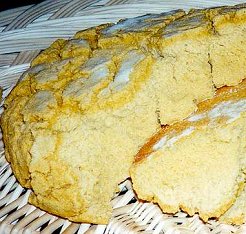 Figure 17 pizza made with flour from “grandinie” (maize) |
||
|
Today I can still guarantee the naturalness of all those foods
that we obtained in symbiosis with nature; made to satisfy precise needs, the
nutritional values of which were guaranteed by tests, with positive results,
carried out for thousands of years; I can especially assure you about the
respectability of our chickens which lived free-range in our farmyard and around
the “massarì”; there are many details that I could tell about them, so maybe I
will write another testimony about them, since some of their behaviour gives
cause for reflection even for present-day “evolved” men. From the alimentary point of view, that day was a further confirmation of the high level of quality of our peasants’ diet; for me those foods have become a parameter for comparison, for everything that I have eaten since then and I think for the same reason that: - I do not eat any food or drink unless I know how or by whom it has been produced; - For new food I have to be certain that it reaches the goals of the consumer more than those of the people who produce and commercialise it; - I always examine whether the food in front of me is a real food or merely the image created for it by publicity; - I have never liked Coca Cola or similar soft drinks and I hate sucking a drink through a straw; instead I prefer a glass of water or milk, a beer, or some wine. The day continued on with rests and meal breaks about every three or four hours. After breakfast my grandmother and I began to carry the “li manoppr” to the front of the “massarì”. More precisely onto the “lu prancatell” (small terrace) in front of the front door of the house. We unpacked the “li manoppr” and laid them out in the sunshine. |
||
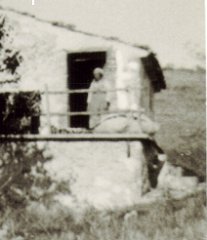 Figure 18 “lu prancatell” the small terrace and grandmother “Filice” at the entrance to the house |
||
| By about midday the whole of the “lu prancatell” was covered in the magic ears of wheat that have always been a symbol of abundance, always the most noble fruit of the earth. In the classical world, not by chance did a crown of ears of grain adorn the head of Ceres (from the Latin), Roman Goddess (related to the Greek Demeter), protective deity for the growth of food plants and cereals which are thus named in her honour. | ||
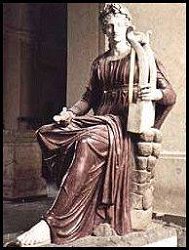 Figure 19 a statue of Ceres |
||
|
After being in the July sun for two hours between 12 o’clock and
2 o’clock, my grandmother judged that we could begin. Since, whilst we were reaping, we had realised that the quantity of ripe grain would be more than our needs for that day, my grandfather continued to harvest it while my grandmother and I had to go on to the next phase of working it. Thus we began the threshing of the grain that had been exposed on the “lu prancatell”. Given the meagre quantity of wheat we did not use machines or animals but rather a method as primitive as it was effective. We put armfuls of wheat stalks onto a heavy hemp blanket; then with two wooden pitchforks we beat the ears of grain until they became separated from the stalks and broke up into pieces; we removed the stalks of straw which no longer had any grain on them and then started the cycle all over again. In the end we had a pile of wheat mixed with the “cama” (husk or chaff in Italian: the covering of the grains of wheat that had become detached with the threshing) and a pile of straw that was put “davendr a lu paiar” (inside the barn). We needed to separate the wheat from the chaff; my grandmother said: “l’ema ventilà” (we must ventilate it). She knew that at that time of day there was a light breeze behind the house; she spread out “lu schiet” (a large, heavy blanket) behind the house, right in the place where you could best feel the slight wind; then together we filled a large “stare” (a wide, light, shallow wooden recipient); my grandmother put it on her head and we went behind the house; she skilfully let the contents of the “stare” fall slowly onto the blanket, perfectly synchronised with the gusts of the light wind; the heavier grains fell near to her feet; the chaff, made very light by the sun, flew further away, carried by the wind. I too wanted to try because it seemed to be very easy; my grandmother was really fond of me so she let me try, but, inexplicably, for me the chaff did not separate from the grain. We did everything very carefully, so as not to waste even one grain of wheat; little by little as we separated it from the chaff we put it into a sack and at the end we had a quantity of wheat at our disposition that was sufficient for our needs. The problem of the availability of wheat seemed to me to have been resolved, but my grandmother said that the grain still had to be washed; for that purpose we went to the well to draw the water, she with her conca and me with a bucket; washing cleaned the grain of any residue of the husks or dust; after that my grandmother cleared “lu prancatell”; she laid a clean blanket on the terrace and spread the washed grain on the blanket; the strong July sun had to both dry it and make it hard so it could be milled. While we were waiting for the sun to perform this last task, we two also went back to the reaping. In the afternoon my grandfather had to go back to the house, although I cannot remember for what reason, and before he left the harvesting my grandmother told him to look and see whether the wheat which had been left to dry was ready yet for milling. On his return my grandfather said that he hadn’t been able to tell whether the wheat was ready or not; my grandmother was annoyed and replied: it is so easy, all you have to do is chew a few grains and if they break up into small pieces it means that the grain is ready. There was an icy moment because with this explanation my grandfather too became angry; I remember that tension well because it made me feel so embarrassed and insecure. After a few minutes, however, my grandfather burst out: I know very well how to do it, but don’t you remember that I lost my teeth some time ago; everybody burst out laughing and harmony was restored once more. My grandmother and I went to check it out; the wheat was ready so we put it into two sacks, she would carry the larger one on her head and I would carry the much smaller one on my shoulder. Under the still hot sun, we began to climb with our loads, the forty minutes of country road which wound its way up from the “casetta” to Torricella where the mill of “Mast Quirine”[2] was situated; it was where the road leads off the Corso towards the cemetery; it was a low building in red bricks; on either side of the door there were two large metal notice-boards, with pictures and writing in colours, advertising the shipping companies that took emigrants to fantastic worlds: to America and Australia. The cunning sellers of voyages in those times knew that the mill was much visited and waiting times were quite long, so people could have long discussions about the marvels offered by the two posters. In reality the mill’s clients were saddened by those invitations since, for most people, those dream places were out of reach due to the high cost of the journeys and the difficulties of obtaining permits; however, you did not hear them discussing the uprooting of affections for their dear ones, or for the things which, until then, they had lived for and had cherished, both physically and psychically; later I was able to explain this silence by the courage, determination and natural reserve of our people. Inside the mill everything was made of wood, with the “macine” (millstones) made of stone, no longer driven by animals or water but by the modern method of “la letrica” (electric energy); inside everything was covered by a heavy whitish covering. The building was still there a few years ago even though it no longer functioned as a mill. When we arrived at the mill, sweating and tired, there were not many people waiting, perhaps because of the unusual hour. We paid for the milling by handing over a part of the grain; we took back our sacks and set off again towards the “massarì” which we reached after about thirty minutes beneath a sun that by now was becoming tamed by the evening hours. My grandmother stayed in the house to get our dinner ready and I returned to the reaping with my grandfather who was still at work in the wheat-field. When the sun began to set we gathered up our things and we too went towards the house; I sat on the steps of the staircase that led up to the “prancatell” in front of the door of the “Massarì”. |
||
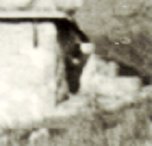 Figure 20 steps of the staircase that led up to the “prancatell” |
||
|
Sitting there I did not think about the work done on that endless
day, nor of the heat I had endured, nor of the misfortunes of my far away
parents, nor of the hard trials that were awaiting me in the future. I was tired that day, but unconsciously satisfied since, in harmony and in collaboration with the earth, the plants and the sun, and in tune with all of nature that surrounded us, we had solved a problem. I was completely absorbed and was living those moments with all that was within me. In front of me was the farmyard and beyond that was the country road that ran alongside it; the road to the right extended to and went between the hills and cultivated hillsides that lay to the south; to the north other pathways joined it and it lead decidedly upwards towards Torricella. Whilst the summer heat was abating, we could see little families passing by along the road, walking slowly together with a donkey, some sheep or other animals, towards their well-deserved rest after a very long day’s work in the fields. The swift, safe swallows screeched in skimming flights searching for something invisible. Behind me the sun sent the last rays of light from the mountains. The first stars began to appear; gradually flights of bats took the place of the swallows. The sky was filling with more and more shining points. It was night when everything around seemed to throb as thousands of flashing dots appeared; they were the fireflies. There was a light breeze, a perfumed wind that seemed to penetrate and gave new strength to my weary limbs. I trembled with all the nature that was around me, with the starry universe, with the outlines of the mountains that surrounded me, with the perfume in the air; I felt as if I were a small part of that marvellous world all around me; I was in a similar state of mind to that which I feel today when I listen to Schiller’s verses in the chorus of Beethoven’s Ninth Symphony. The next night too announced its magic in advance, full of positive suggestions. At a distance of so much time, I relive those same sensations when I admire a work of art in which the author portrays such a night as that which I had live under those circumstances. |
||
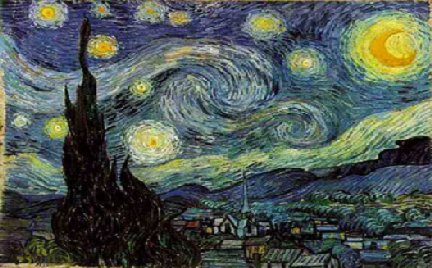 Figure 21 a magic night ('Starry Night' - Van Gogh) |
||
|
“E’ pront a magnà”
(dinner’s ready), my grandmother interrupted me. On the way home from the mill my grandmother had procured some wood and had fed the fire; she had been to draw water from the well that was about one hundred metres to the east of the “masssarì”, at the foot of the hill that also formed a part of the annexed lands; the water there was fresh and pure in every season. She had cared for all the animals; she had passed the flour through the sieve, to separate it from the bran, that flour which had cost us so much effort. |
||
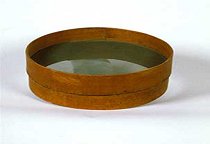 Figure 22 sieve or sifter for separating the flour from the bran |
||
|
With a small quantity of this she had prepared the dough for a
focaccia which she had cooked under the embers of the hearth: she had cleaned
out the ashes and other residues of the fire from the red-hot bricks on which
the fire had been made; she had placed the focaccia there, covering it with the
“la copp” (shallow iron cup with an iron handle, used upside-down; it was placed
on top of food to be cooked under the embers; once it was in place everything
was covered with the charcoal itself). Her instinct and her experience told her when it was time to take the focaccia from the fire so it would be well cooked but not burnt. She had mixed together suitable quantities of flour and eggs; she rolled out a layer from the mixture, made without water, using her rolling-pin; she folded this like an accordion and then cutting it with her knife she made “le sagn” (long strips of pasta about one centimetre wide). With “le sagn” and beans of our own production, that had begun to be cooked the night before, and with all the other ingredients also of our own production, my grandmother had prepared a memorable dish of pasta and beans. Many years later I asked myself whether the good quality of those foods had been real or the fruits of my childhood imaginings. To find the reply, in more cases than one, I tried to find ingredients as similar as possible to those which our peasants had used to use, and I tried to cook the same things. The results that I obtained confirmed the veracity of my memories every time. Unfortunately, today it is very difficult, if not impossible, to find ingredients of the same level of quality.[3] The miracle was carried out in this way: what had been luxuriant stalks under the sun in the morning in an immense blond expanse, by evening had been transformed into an elaborate and tasty bread of top quality. The next morning my grandparents let me sleep later than usual and I awoke to the scent of bread coming out of the oven, which had invaded the whole house since the oven was at the side of the hearth (to learn how my grandmother made bread see note[4]). |
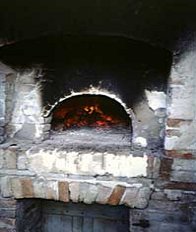
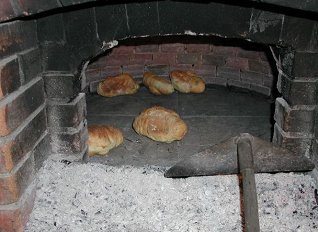 Figure 23 the wood fire in our house |
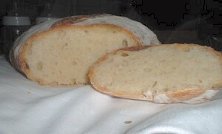 |
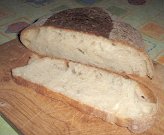 |
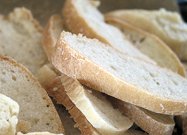 |
| Figure 24 bread | ||
|
This was not the only surprise, apart from the bread, my
grandmother had also used the flour from our wheat to make and cook a pizza;
using the same dough as the bread, but made very thin, so that on cooking in the
boiling hot oven it formed two layers of crusts that were clearly separated. My grandmother had filled the empty part with ricotta that she had made from our goats’ milk. I had a breakfast of bread and milk and pizza with ricotta: the Bread operation had been completed and tested. Frascati(Rome), January 2006 Giosia Aspromonte |
|
FOOTNOTES: [1] Torricellan Proverb. In
English: Beatings and bread make the children healthy; beatings and loaves of
bread make the children beautiful; to summarise: discipline and healthy food
make the children healthy and beautiful. |
||
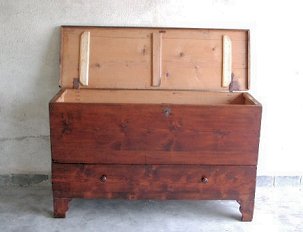 |
|
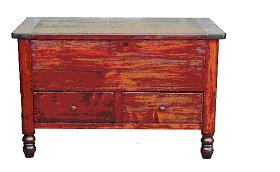 |
|
The quantity of yeast needed to make bread varied according to
the type of flour and to the temperature: but usually she would use about 10 to
20 grammes of yeast per kilogramme of flour to be mixed. In order that the first portion of dough, which she formed with the yeast and a part of the flour, should reach the required degree of fermentation, it would take 4 to 5 hours in the summer and 8 to 12 in the winter. The dough thus leavened would almost double in volume, becoming swollen and rounded in shape; it gave out a pleasant odour, became elastic, and pushed back your hand when you pressed it. The Dough When it was time to mix the rest of the already prepared flour, she began to dissolve the salt in a little lukewarm water – 5 to 10 grammes of salt for each kilogramme of dough – and she would blend this with the yeast, adding more water to it, a little at a time, whilst at the same time incorporating into it more and more of the flour, always being careful not to let any lumps form. In this way she obtained a dough of the correct consistency which she manipulated, beat and punched with her fists. Then she would spread it out on the base of the kneading trough, folding it on itself, and so on, over and over again for about 25 or 30 minutes, so that the whole dough became assimilated and uniform. The kneading was neither slow nor hurried, but she carried out this operation in a regular way without any interruptions. |
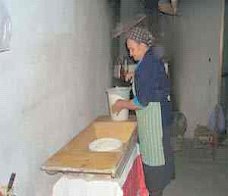 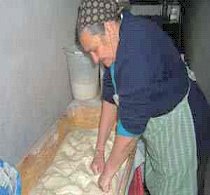 |
|
Once the dough had been kneaded, if the season was cold she would
leave it to rest for half an hour on a wooden table at a mild temperature; in
the hot season, instead, she divided the dough itself to make loaves out of it
each of a weight suitable for baking. Then she would split up the dough into balls, which she shaped into cobs (loaves), working them with her hands as necessary, then she would sprinkle a little flour on the top of them. Having made the loaves she then put them onto a table, covered with a large canvas cloth, and, leaving them exposed to the air in the summer, or close to the oven in the winter, she would then cover them with a canvas, or a cloth, so that the dough could have time to rise sufficiently before being baked. Baking She organised the oven so that it was ready and hot at the right moment, and so she began to heat it as soon as she had shaped the loaves and whilst she was waiting for them to rise sufficiently. She only used well dried wood, which produced a pure flame and no smoke; and later she burned twigs one by one in various points of the oven to make the heat uniform everywhere. When a twig had burned she would use the poker to pull the glowing charcoal towards the mouth of the oven, and make piles of these at the two sides. To put the bread into the oven she would place the loaves – already sprinkled with flour – one at a time on the baker’s shovel (paddle); and after having rapidly held and reshaped the loaves with her hand, she would place them into the oven and then let them slide off, quickly drawing out the shovel itself. Having done this with all the loaves, she would close the mouth of the oven, reopening it about a quarter of an hour later, to keep an eye on the baking, to remove loaves that were ready or to change the position of any needing to be changed. Ordinarily half an hour or three quarters of an hour was enough to cook small loaves, or those made of a lighter dough, whilst larger ones, or those made with a denser dough, needed to stay in the oven for about an hour and a half. She knew that bread bakes best when cooked slowly at a moderate heat; if the oven is too hot, the crust may colour up quickly, but the dough inside the loaf remains almost raw. |
||
|
|
||
|
My grandmother knew
that you must never put bread into a closed place whilst it was still warm,
because it would easily acquire a bad smell, or it could even become mouldy,
especially if kept for many days. |